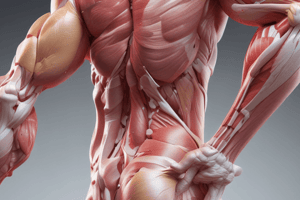Podcast
Questions and Answers
Muscle power is a product of force and velocity.
Muscle power is a product of force and velocity.
True (A)
Muscle tone refers to the amount of resistance to movement in muscles.
Muscle tone refers to the amount of resistance to movement in muscles.
True (A)
Tendons connect muscles to bones.
Tendons connect muscles to bones.
True (A)
Resistance training improves flexibility.
Resistance training improves flexibility.
Eating extra protein builds muscle.
Eating extra protein builds muscle.
Which movement should a joint mobilization begin with?
Which movement should a joint mobilization begin with?
Which manual therapy technique involves holding the body in strategic positions for 90-second intervals to allow the sensory receptors within the muscle to relax?
Which manual therapy technique involves holding the body in strategic positions for 90-second intervals to allow the sensory receptors within the muscle to relax?
Which manual therapy technique involves the use of tools (instruments) to mobilize the muscles and joints?
Which manual therapy technique involves the use of tools (instruments) to mobilize the muscles and joints?
Which of the following is a relative contraindication for cryotherapy?
Which of the following is a relative contraindication for cryotherapy?
Which of the following is a deep heating modality?
Which of the following is a deep heating modality?
Match the following joint dislocations with their common positions:
Match the following joint dislocations with their common positions:
Match the following joint dislocation terms with their definitions:
Match the following joint dislocation terms with their definitions:
Flashcards are hidden until you start studying




